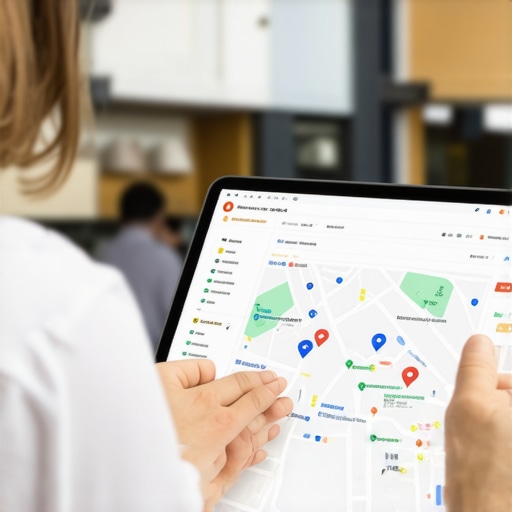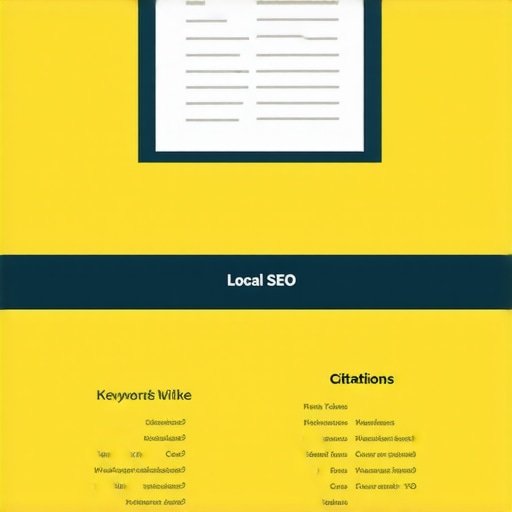My Personal Encounter with Google My Business Optimization
Starting my local business journey, I quickly realized how crucial it was to stand out on Google Maps and local search results. I remember the first time I tried to improve my Google My Business (GMB) profile; I was overwhelmed by the sheer amount of information and strategies available. It felt like navigating a complex maze. However, after some trial and error, I discovered the power of professional GMB optimization services and how they can dramatically elevate your local rankings.
Why I Switched to a Professional GMB Optimization Service
Initially, I attempted DIY methods, such as keyword stuffing and inconsistent posting. But I noticed my competitors, who invested in expert optimization, started appearing on the coveted Google Maps 3-Pack. That’s when I realized the importance of a targeted, strategic approach. I found that effective Google My Business optimization isn’t just about filling out a profile; it’s about fine-tuning every element, from NAP consistency to engaging descriptions, to Google Maps SEO strategies that truly work. For comprehensive insights, I recommend reviewing GMB optimization secrets.
What Makes a Top Local Ranking Strategy Work?
In my experience, it’s a combination of technical SEO, engaging content, and reputation management. I learned that optimizing my GMB profile for local SEO meant paying attention to keywords like “best coffee shop near me” or “local bakery in town” and making sure my profile was consistently updated with fresh photos and posts. Additionally, leveraging Google My Business ranking tips, such as acquiring genuine reviews and maintaining accurate business info, was a game-changer. I also discovered that using Google Maps SEO services can accelerate the process and help you reach the top positions faster.
How Can I Keep My GMB Profile Ahead of the Competition?
Staying ahead requires continuous effort. I regularly monitor my profile performance, respond to reviews, and optimize my posts based on the latest SEO practices. Utilizing tools like GMB ranking software can help identify ranking opportunities and gaps. I also make sure to stay informed about Google’s evolving algorithms through authoritative sources, such as Google Maps Mastery. It’s a dynamic process, but with dedication and the right strategies, your local business can dominate search results.
If you’re serious about boosting your local visibility, I highly encourage exploring professional GMB solutions tailored for rapid rankings. And don’t forget—sharing your experiences or questions in the comments can be incredibly valuable for others on the same journey!
Unlocking the Hidden Power of Local Keywords for Google Maps Domination
One of the most overlooked aspects of Google My Business optimization is the strategic use of long-tail and niche-specific keywords. While basic keywords like “best pizza near me” are essential, diving deeper into specific search queries tailored to your service area can give you a significant edge. For example, instead of just “plumber,” consider “emergency leak repair in Brooklyn.” These targeted keywords align more precisely with what potential customers are searching for, increasing your chances of ranking higher in local results. To refine your keyword strategy, explore tools that analyze local search intent and incorporate these insights into your profile updates.
How Does Google’s Algorithm Evolve and Impact Local Search Rankings?
Understanding Google’s algorithm updates is crucial for maintaining and improving your local rankings. Recent changes emphasize user experience signals, such as review quality, engagement, and website authority, over mere profile completeness. For instance, Google now prioritizes fresh, relevant content and positive customer interactions. Staying informed through authoritative resources like Google Business Profile SEO updates ensures your strategies adapt to these evolving factors. Regularly auditing your profile and keeping content fresh can help you stay ahead of competitors and leverage algorithm shifts effectively.
Visualizing your local SEO strategy can be a game-changer. An infographic illustrating the interconnected elements—keywords, reviews, profile optimization, and local backlinks—can clarify complex strategies and motivate ongoing efforts. Incorporating visual content not only enhances user engagement but also signals activity to Google, which can positively influence rankings. Consider creating custom visuals that highlight your unique value propositions and local market insights to further differentiate your profile.
What Are the Practical Steps to Sustain Long-Term Success in Google Maps Rankings?
Achieving top rankings is only the beginning; maintaining them requires a proactive, multi-faceted approach. Regularly monitor your profile analytics to identify changes in user behavior and search trends. Respond promptly to reviews—both positive and negative—to foster trust and engagement. Additionally, build local citations and backlinks from reputable sources to reinforce your authority. Incorporating customer feedback into your service improvements can also boost your reputation, leading to more organic reviews and higher visibility. For a comprehensive roadmap, consulting trusted sources like local SEO experts can provide actionable insights tailored to your niche.
If you’re eager to propel your local business to the top, exploring professional Google Business Profile SEO solutions can accelerate your progress. Sharing your own experiences or asking questions in the comments can foster a community of growth-minded local entrepreneurs!
Deepening My Understanding of Local SEO Nuances
As I continued my journey in optimizing Google My Business profiles, I realized that staying ahead in local search rankings requires a keen awareness of the subtle shifts in Google’s algorithms. For instance, Google’s recent emphasis on user engagement signals and local relevance compelled me to refine my approach further. I began exploring how Google Business Profile SEO incorporates behavioral metrics, such as click-through rates and dwell time, to determine local rankings. This insight pushed me to focus not just on profile optimization but also on boosting user interaction through compelling posts and timely responses.
The Complexity of Managing Reputation and Trust
Reputation management is a complex, ongoing process. I found that acquiring genuine reviews is just part of the puzzle; maintaining a consistent, positive online reputation involves actively engaging with customer feedback, resolving issues transparently, and encouraging satisfied clients to share their experiences. I experimented with tools that provide real-time monitoring of reviews and mentions, which allows me to respond promptly and tactfully. This continuous engagement signals to Google that my business is trustworthy and customer-centric, vital factors for maintaining high rankings in competitive areas. For a deeper dive into reputation strategies, I recommend reviewing promotion techniques for local SEO.
Leveraging Local Backlinks and Citations for Authority
Another layer of my strategy involved building authoritative local backlinks. I found that securing mentions from reputable local websites, industry directories, and community blogs significantly boosts my profile’s credibility. However, the process isn’t as straightforward as submitting listings—it’s about cultivating genuine relationships with local influencers and organizations. I also learned that consistency in NAP (Name, Address, Phone Number) across all citations is critical. To streamline this, I use citation management tools that help ensure uniformity and monitor new backlink opportunities. The cumulative effect of these backlinks and citations enhances my local authority, making it easier to retain high rankings even amidst algorithm updates.
Understanding and Navigating Algorithm Evolution
Google’s algorithm updates can feel like a moving target, but understanding their intent helps me adapt. I stay informed through authoritative sources and analyze how changes affect my rankings. For example, recent updates have placed a higher value on user-generated content and local relevance. In response, I focus on creating community-oriented content, sharing local news, and highlighting customer stories. I also pay attention to Google Maps 3-Pack mastery techniques, ensuring my profile remains optimized for both search engines and real users. Consistently auditing my profile and adapting to these shifts is essential for long-term success.
Engaging with the Community for Organic Growth
One often overlooked aspect is community engagement. I have found that actively participating in local events, sponsoring community initiatives, and encouraging customers to share their experiences locally not only builds goodwill but also generates organic content and backlinks. These efforts increase my business’s visibility and conversions, as local customers are more likely to trust a business that actively contributes to their community. This holistic approach—combining technical SEO, reputation management, backlinks, and community involvement—creates a resilient strategy that withstands algorithm fluctuations and sustains high rankings.
What are your experiences with adapting to Google’s algorithm updates over time?
Sharing insights and strategies with fellow local entrepreneurs has been invaluable. If you’ve navigated similar challenges or discovered effective tactics, I invite you to share your journey in the comments or explore more advanced techniques through trusted resources like professional GMB solutions. Together, we can master the evolving landscape of local SEO and ensure our businesses thrive in competitive markets.
Refining Local SEO with Precision Targeting and Data-Driven Insights
As my expertise deepened, I began leveraging advanced analytics tools to dissect local search patterns meticulously. Platforms like Google Business Profile SEO analytics empower me to identify nuanced shifts in customer behavior, enabling hyper-targeted optimization. I integrate data from local competitor analyses, Google Trends, and customer feedback to refine my keyword strategy continually, ensuring my profile remains at the forefront of relevant searches.
Harnessing Behavioral Metrics for Long-Term Dominance
Understanding Google’s evolving algorithm involves more than surface-level optimizations; it requires mastery of behavioral metrics like click-through rates, dwell time, and engagement signals. I focus on crafting compelling, localized content that resonates emotionally with my audience—be it through storytelling, community involvement, or showcasing local testimonials. This approach not only elevates user interaction but also signals to Google that my profile offers genuine value, reinforcing top rankings. For a comprehensive approach, I often revisit GMB CTR tips to keep my engagement strategies sharp.
Building Resilient Local Backlink Ecosystems
One of my most potent tactics involves cultivating a resilient ecosystem of local backlinks. I foster authentic relationships with influential local bloggers, industry authorities, and community organizations, encouraging them to feature my business naturally. This organic backlink profile, coupled with consistent NAP citations across high-authority local directories, creates a formidable web of trust signals. I also utilize citation management tools to maintain consistency and identify new backlink opportunities proactively.
Adapting to Algorithmic Nuances with Ethical SEO Practices
Google’s algorithm shifts are complex, often emphasizing user experience and relevance over keyword stuffing or manipulative tactics. I stay ahead by adhering to ethical SEO practices—prioritizing quality content, genuine reviews, and authentic engagement. Regular audits, such as checking for NAP consistency and review authenticity, help me spot potential issues before they impact rankings. I also keep abreast of updates via authoritative sources like Google Maps mastery and adapt my strategies accordingly, ensuring my profile remains compliant and competitive.
Encouraging Community-Driven Content for Organic Growth
Engaging actively with my local community generates organic content that Google loves. I host and sponsor local events, encourage satisfied customers to share their stories, and participate in neighborhood initiatives. These activities naturally generate reviews, backlinks, and social proof, creating a virtuous cycle of growth. I also leverage user-generated content within my profile and posts, making my listing a vibrant reflection of local life that appeals both to Google and potential customers. For insights into building such community momentum, I consult resources like promotion techniques for local SEO.
How Can I Keep Up with Rapid Changes in Local Search Algorithms?
Staying ahead requires continuous learning and agility. I subscribe to industry newsletters, participate in webinars, and join local SEO communities to exchange insights. Regularly updating my knowledge base allows me to implement innovative tactics swiftly, whether it’s optimizing for new ranking factors or responding to shifts in consumer search intent. I believe that a proactive, informed approach is essential for long-term dominance in Google Maps rankings. I invite you to share your experiences or ask questions—let’s deepen our collective mastery of local SEO!
Things I Wish I Knew Earlier (or You Might Find Surprising)
Hidden Power of Niche Keywords
One thing I underestimated early on was how much long-tail, niche-specific keywords could boost my local rankings. Instead of just targeting broad terms like “coffee shop,” I started focusing on more specific phrases like “artisan coffee shop near university district.” This shift dramatically improved my visibility for highly relevant searches, and I wish I had started this earlier.
The Importance of Consistent NAP Data
I was surprised at how much inconsistency in my Name, Address, Phone number (NAP) citations affected my rankings. Ensuring uniformity across all listings and directories created a more trustworthy profile in Google’s eyes, which helped me climb higher in local packs faster than I expected.
User Engagement Signals Matter More Than Ever
Google’s recent updates emphasize user engagement—clicks, reviews, and dwell time. I noticed that actively responding to reviews and posting engaging updates kept my profile fresh and relevant, leading to better rankings. It’s a reminder that your community interactions are just as vital as technical SEO.
Visual Content Boosts Local Trust
Adding regular high-quality photos and videos of my business made a noticeable difference. Visual content humanizes your brand, encourages more reviews, and signals activity to Google, all of which contributed to improved local visibility.
Local Backlinks Are a Game Changer
Building genuine relationships with local bloggers and community sites to earn backlinks significantly strengthened my profile’s authority. It’s not just about citations but creating a web of local trust signals that Google values highly.
Resources I’ve Come to Trust Over Time
- Google’s Official Blog: Staying updated with Google’s latest algorithm changes has been crucial. I recommend checking it regularly to adapt your strategies accordingly.
- Moz Local Search Resources: Moz’s guides on local SEO and citations are thorough and easy to understand, making complex topics accessible for beginners and experts alike.
- BrightLocal Blog: Their case studies and practical tips helped me refine my local SEO tactics and understand what actually works in real-world scenarios.
Parting Thoughts from My Perspective
Optimizing your Google My Business profile is a continuous journey, and I’ve learned that embracing both technical strategies and community engagement yields the best results. The most valuable lesson is that genuine interactions, consistent data, and strategic keyword use can truly elevate your local presence. If this resonates with you, I’d love to hear your thoughts—whether you’re just starting or already deep into local SEO. Sharing experiences can help us all grow and succeed in this competitive landscape. Feel free to drop your insights or questions in the comments!


